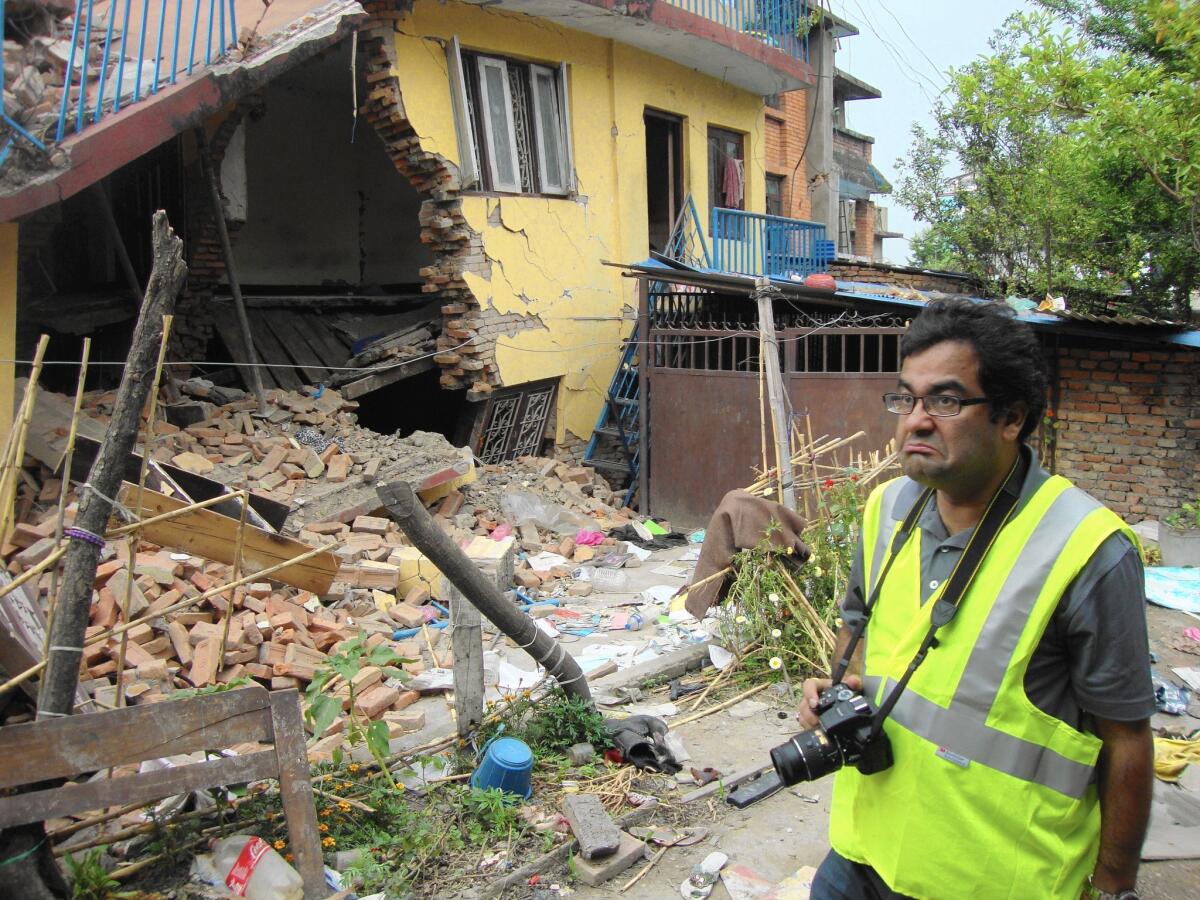Great Read: Quake engineer returns to Nepal to learn from disaster

Binod Tiwari leaps out of an SUV onto the busy Araniko Highway and stops in front of a foot-wide crack in the pavement.
As trucks and motorcycles whiz by, Tiwari, wearing a fluorescent yellow vest over his Cal State Fullerton shirt, raises his camera to snap photographs of the crack. A bridge nearby shows similar fractures, and Tiwari walks alongside it to check some nearby homes that tip perilously forward.
“Definitely has lateral spreading,” he mutters as he snaps photos. At times, he props a yellow ruler or his cellphone next to the cracks to measure them.
Tiwari, a civil engineer at the Fullerton university, has come to Nepal to help lead the Geotechnical Extreme Events Reconnaissance team, which assesses the damage after mega-earthquakes such as the magnitude 7.8 one that ripped through Nepal in April. They want to find out what happened to the rock and soil during the quake, and which buildings and infrastructure responded well — or didn’t.
The best way to learn how to build safer structures, Tiwari says, is to head to the disaster zones where they have failed.
“Natural disasters come without telling us,” he says. “Science has to chase that disaster.”
The team has brought along a host of different experts. Tiwari studies soil liquefaction, a phenomenon that sometimes occurs during earthquakes that causes the soil to move like a fluid instead of a solid, tipping buildings as if pulling the rug out from under them.
The scientist made a similar research trip after the 2011 earthquake and tsunami in Japan. But here, the physical damage cuts a far wider swath across the country — and for the Nepalese-born researcher, it hits closer to home.
Tiwari was born in Gorkha district in a mud-mortar house, the kind of building that proved deadly during the quake. When he was a teen, his family moved to Katmandu, the capital, where he would look through his window at the sky-scratching Himalayas.
“All around you see snowcapped mountains. So that makes your life a little different,” he says. “If you feel a little sad, you just look into the mountains.”
Beautiful as they are, the soaring peaks are caused by the same forces that make Nepal such a dangerous earthquake zone.
As members of the geotechnical team travel across the city and visit villages, they see children and elderly Nepalese sleeping in the open, huddling under tarps near flattened and crumbling houses.
It’s “devastating,” Tiwari says. “You want to cry.”
::
It’s cool on this gray spring day; the overcast sky threatens to rain, a foreshadowing of the season to come.
“You should follow the cracks through the buildings, it’s spectacular,” says Scott Kieffer, Tiwari’s co-leader on the team, a California native now based at Graz University of Technology in Austria, who has already scoped out the area.
“I just want to go there,” Tiwari replies, pointing across the bridge. On the other side, he traces the cracks down an alley, over a construction site, into a mechanic’s garage, snack shop and finally a man’s backyard.
Tiwari’s ability to connect with Nepalese people on the ground and in government is essential to the team’s mission. Earlier in the day, he chatted in Nepali with Tulasi Prasad Sitaula, the secretary of physical infrastructure and transport. Now, as he tracks the damage into the rubble-filled yards of damaged homes, Tiwari asks residents for details on what happened during the quake.
“We’ve got to have somebody who has connections there. We’re lost without that,” Kieffer says. “Thank goodness for Binod.”
Being able to hit the ground running is key, because the scientists are working in a shrinking time window: After the humanitarian rescue operation, but before the geophysical evidence that they need to find is erased by the monsoon rains that sweep through the region during the summer.
Nepalese people are known for being quick hikers, and Tiwari has the rest trailing him.
“In my heart, I am still Nepali,” he calls over his shoulder.
Tiwari and the team, which is supported by the U.S. National Science Foundation, are examining every bit of infrastructure they come across — bridges, roads, houses and hydropower projects.
But they’re also looking at how different types of soil reacted, in part to identify slopes in this mountainous country that have a high risk of landslide. Finding those structural weaknesses in the terrain now will allow them to better predict which slopes are most likely to give way when the monsoon comes — and make sure that residents are out of harm’s way.
Soil also plays a role in whether a building survives an earthquake — its composition, the grain size, how densely packed it is and how much water it’s holding.
Later in the day, in an area called Gongabu, Tiwari climbs under a metal gate to examine a three-story brick-and-concrete school that has sunk, its side sheared off so that a classroom gapes open next to the basketball hoop.
The principal’s son joins Tiwari and his team as they stand next to a mural depicting Charles Darwin, Marie Curie and Galileo. He explains that school officials had built the structure to withstand an 8.0 quake.
“But they didn’t check the soil profile,” Tiwari says, shaking his head. “If you don’t check the soil, how do you build a foundation?”
::
Tiwari and his team were driving on the Araniko Highway when the magnitude 7.3 aftershock hit the region May 12. The ground lurched and their car swayed as if rocked by high waves.
It was like “some big elephant coming to your car and shaking the car,” Tiwari says.
The members of team were headed east to Charikot in the district of Dolakha, one of the hardest-hit areas. But they quickly made a U-turn to Katmandu, to find out how this major quake affected roads already cracked by the original temblor.
Driving back, they soon saw signs of this one-two punch: Buildings that had been standing when the team drove past to leave the capital were reduced to rubble.
Once they were done examining the wreckage in Katmandu, which was not as extensive as it could have been, they headed back toward the epicenter of the aftershock.
It was a frightening drive; the highway cuts through mountainous terrain, and debris loosened by the shaking could have come down on them.
“Buildings you can see — but landslides, you have no idea where they’re coming from,” Tiwari says. “Big boulders, big rocks.”
But there was no question of turning back, because the aftershock presented an important scientific opportunity: They’d be able to see the damage just hours after a major earthquake hit.
“We were scared, but we kept on going,” Tiwari says.
The damage was extensive near the epicenter: Homes made with mud mortar and unreinforced masonry had fallen apart. Several buildings had pancaked.
“They don’t have money to buy cement, but the clay is available everywhere, mud is available everywhere, water is available and the stones are available,” he says of the residents. “They grab stone from the mountain, with the help of their friends and neighbors, and then they get mud and water and they help each other out to build the house.”
::
Before returning to California, Tiwari spends the last few days of his trip giving talks to geotechnical and civil engineering groups based in Nepal. It’s not how he planned to spend his time, but the country’s building codes will need to be rebuilt as well, because the current standards don’t take the nature of the ground beneath them into account.
“In the U.S., we do an investigation and then we design; here the investigation is very poor because people do not know how to do it,” Tiwari says.
In some ways, Tiwari says, he’s surprised by the limits of the damage — in many places the soil seemed to damp the waves of shaking from the earthquake, though the team is still studying the soil to find out how this happens.
Scientists will have to study the soils in different regions around Nepal to fully understand which areas are safe to build in, he adds.
Years ago, right after graduating from Tribhuvan University near Katmandu, Tiwari built his own house. He’d designed it well, and it survived the quake.
His mother still lives there, but she and terrified neighbors had refused to return to their homes, living together in a long tent on his frontyard for weeks as aftershocks continued.
“She was scared, but I just wanted to console her,” Tiwari says. “Earthquakes are natural things, but you have to be ready to face them.”
Tiwari knew he could not leave them until he had examined the buildings himself. They needed to feel safe, and they trusted him.
“I checked everyone’s house and told them, ‘Don’t worry, go back to your house and sleep well there,’” Tiwari says. “And they did, they did.”
Hennessy-Fiske reported from Katmandu and Khan from Los Angeles.








